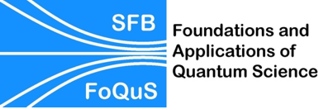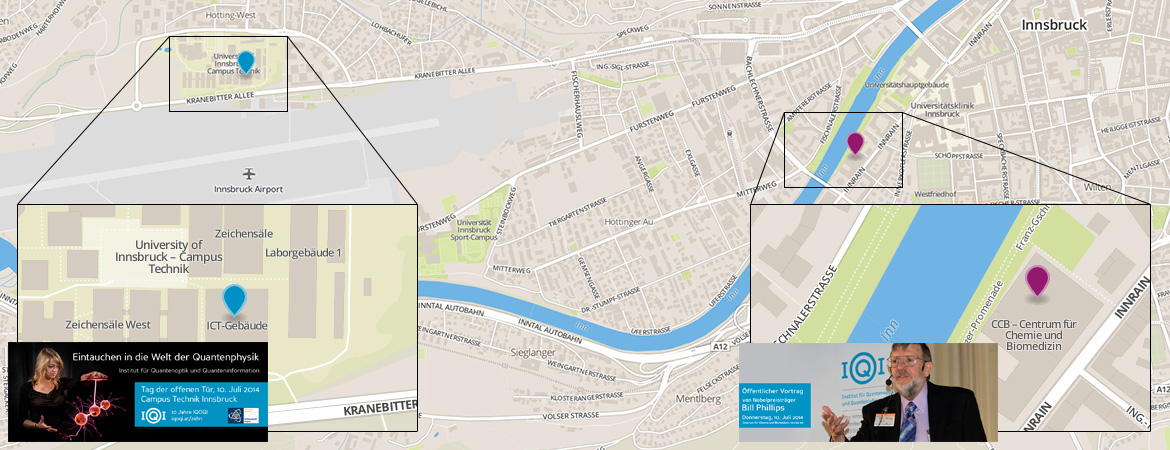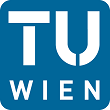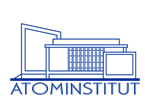 | ||||||||||||||||||||||||||
Projects
| 26th SFB FoQus meeting — Innsbruck, July 10th[joint events with the SFB Introductory Course on Quantum Information]Thursday's talks are in Hörsaal C.
26th SFB FoQus meeting — Innsbruck, July 11thFriday's talks are in Hörsaal A.
AbstractsTwo-orbital quantum gases with ultracold ytterbiumSimon Fölling, LMU Munich Modern experiments with ultracold atoms demonstrate an ever increasing control over the dynamics and interactions between particles, allowing for a very close modeling of quantum many body systems with both external and increasingly with internal degrees of freedom. More complex degenerate systems with Alkaline-earth-like electronic structure such as Ytterbium are being pursued due to the properties of their metastable excited internal "clock" state. In our experiment, we use the clock state as internal degrees of freedom which can be coupled to the external degrees via state-dependent potentials. One motivation to use these states is to implement Kondo lattice-type physics with two orbitals. We characterize the very strong spin exchange coupling between the two clock states of Ytterbium 173, leading to a large antiferromagnetic Kondo coupling for the two orbital states, and show that SU(N) symmetry is fullfilled for both states. Quasiparticle engineering and entanglement propagation in a quantum many-body system Petar Jurcevic, IQOQI Innsbruck The key to explaining and controlling a range of quantum phenomena is to study how information propagates around many-body systems. Quantumdynamics can be described by particle-like carriers of information that emerge in the collective behaviour of the underlying system, the so-called quasiparticles. These elementary excitations are predicted to distribute quantum information in a fashion determined by the system's interactions. Here we report quasiparticle dynamics observed in a quantum many-body system of trapped atomic ions.First,we observe the entanglement distributed by quasiparticles as they trace out light-cone-like wavefronts. Second, using the ability to tune the interaction range in our system, we observe information propagation in an experimental regime where the effective-lightcone picture does not apply. Characterizing topological order with matrix product operators Burak Sahinoglu, Uni Wien We propose minimal algebraic rules to characterize topological order in states which can be described as a tensor network state (TNS) in two dimensions. The main object is matrix product operator (MPO), which defines the local tensor up to an isometry. The key algebraic rule, which we call pulling through, makes the strings of MPOs mobile on the lattice except the end points. As an example, we explicitly give the MPO for string net models in 2D and show that it satisfies all proposed algebraic rules. In particular the pentagon equation for F-symbols comes out to be the pulling through condition, giving a meaning to it in TNS picture. This scheme generalizes G-injective PEPS, which can describe quantum double models, and as our construction shows, covers string-net models, hence opens a way to find topologically ordered states beyond string-nets. At the end we discuss other possible applications and open directions in the light of this proposal for the search of topological order. Self-ordering dynamics of ultracold atoms in multicolored cavity fields Sebastian Krämer, ITP Innsbruck We study light induced spatial crystallization of ultracold quantum particles confined along the axis of a high-Q linear cavity via a transverse multicolor pump. Whenever a pump frequency is tuned close to resonance with a longitudinal cavity mode, the dynamics favors bistable spatial particle ordering into a Bragg grating at a wavelength distance. Simultaneous pumping at several resonant frequencies fosters competition between the different spatial lattice orders, exhibiting complex nonlinear field dynamics involving several metastable atom-field states. For few particles even superpositions of different spatial orders entangled with different light mode amplitudes appear. By a proper choice of trap geometry and pump frequencies a broad variety of many particle Hamiltonians with a nontrivial long range coupling can be emulated in such a setup. When applying quantum Monte Carlo wave function simulations to study time evolution we find simultaneous super radiant scattering into several light modes and the buildup of strong non-classical atom field correlations. Quasi-adiabatically encircling exceptional points Thomas Milburn, TU Wien The appearance of exceptional points in the complex eigenvalue spectra of non-Hermitian systems, which describe, for example, the dynamics of coupled oscillator modes in the presence of loss or gain, is associated with many counterintuitive phenomena. In this talk I will discuss the state flip process predicted for an adiabatic encircling of an exceptional point and show that the actual dynamics differs strongly from the naïve adiabatic prediction. These findings demonstrate a fundamental difference in the quasi-adiabatic evolution of Hermitian and non-Hermitian systems, with relevance for coupled optical, mechanical or microwave modes with time-dependent parameters. The fate of the common cause principle in quantum mechanics Jacques Pienaar, Uni Wien Abstract: I compare some recent attempts to generalise causal models to quantum mechanics, focusing on the ways that these different approaches treat Reichenbach's common cause principle in the presence of quantum entanglement. Map of events for the IQOQI 10 year celebration
| |||||||||||||||||||||||||







